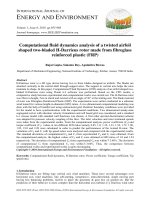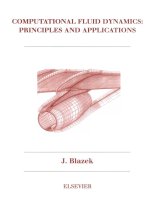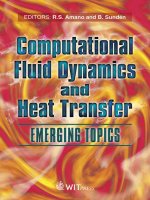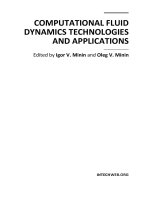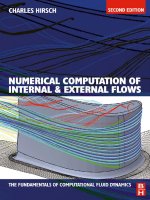APPLIED COMPUTATIONAL FLUID DYNAMICS TECHNIQUES pot
Bạn đang xem bản rút gọn của tài liệu. Xem và tải ngay bản đầy đủ của tài liệu tại đây (11.59 MB, 523 trang )
Simpo PDF Merge and Split Unregistered Version -
APPLIED COMPUTATIONAL FLUID
DYNAMICS TECHNIQUES
Applied Computational Fluid Dynamics Techniques: An Introduction Based on Finite Element Methods, Second Edition.
Rainald Löhner © 2008 John Wiley & Sons, Ltd. ISBN: 978-0-470-51907-3
Simpo PDF Merge and Split Unregistered Version -
APPLIED
COMPUTATIONAL
FLUID DYNAMICS
TECHNIQUES
AN INTRODUCTION BASED ON
FINITE ELEMENT METHODS
Second Edition
Rainald Löhner
Center for C omputational Fluid Dynamics,
Department of Computational and Data Sci ences,
College of Sciences, George Mason University,
Fairfax, Virginia, USA
John Wiley & Sons, Ltd
Simpo PDF Merge and Split Unregistered Version -
Copyright
c
2008 John Wiley & Sons Ltd, The Atrium, Southern Gate, Chichester,
West Sussex PO19 8SQ, England
Telephone (+44) 1243 779777
Email (for orders and customer service enquiries):
Visit our Home Page on www.wiley.com
All Rights Reserved. No part of this publication may be reproduced, stored in a retrieval system or
transmitted in any form or by any means, electronic, mechanical, photocopying, recording, scanning or
otherwise, except under the terms of the Copyright, Designs and Patents Act 1988 or under the terms
of a licence issued by the Copyright Licensing Agency Ltd, 90 Tottenham Court Road,
London W1T 4LP, UK, without the permission in writing of the Publisher. Requests to the Publisher
should be addressed to the Permissions Department, John Wiley & Sons Ltd, The Atrium, Southern Gate,
Chichester, West Sussex PO19 8SQ, England, or emailed to , or faxed to
(+44) 1243 770620.
Designations used by companies to distinguish their products are often claimed as trademarks.
All brand names and product names used in this book are trade names, service marks, trademarks or
registered trademarks of their respective owners. The Publisher is not associated with any product or
vendor mentioned in this book.
This publication is designed to provide accurate and authoritative information in regard to the subject
matter covered. It is sold on the understanding that the Publisher is not engaged in rendering professional
services. If professional advice or other expert assistance is required, the services of a competent
professional should be sought.
Other Wiley Editorial Offices
John Wiley & Sons Inc., 111 River Street, Hoboken, NJ 07030, USA
Jossey-Bass, 989 Market Street, San Francisco, CA 94103-1741, USA
Wiley-VCH Verlag GmbH, Boschstr. 12, D-69469 Weinheim, Germany
John Wiley & Sons Australia Ltd, 42 McDougall Street, Milton, Queensland 4064, Australia
John Wiley & Sons (Asia) Pte Ltd, 2 Clementi Loop #02-01, Jin Xing Distripark, Singapore 129809
John Wiley & Sons Canada Ltd, 6045 Freemont Blvd, Mississauga, ONT, L5R 4J3
Wiley also publishes its books in a variety of electronic formats. Some content that appears in print may
not be available in electronic books.
Library of Congress Cataloging-in-Publication Data
Löhner, Rainald.
Applied computational fluid dynamics techniques : an introduction based on finite element methods /
Rainald Lohner. – 2nd ed.
p. cm.
Includes bibliographical references and index.
ISBN 978-0-470-51907-3 (cloth : alk. paper)
1. Fluid dynamics–Mathematics. 2. Numerical analysis. 3. Finite element method. I. Title.
TA357.L592 2008
620.1’064–dc22
2007045555
British Library Cataloguing in Publication Data
A catalogue record for this book is available from the British Library
ISBN 978-0-470-51907-3
Typeset by Sunrise Setting Ltd, Torquay, UK
Printed and bound in Great Britain by Antony Rowe Ltd, Chippenham, Wiltshire
This book is printed on acid-free paper responsibly manufactured from sustainable forestry in which at
least two trees are planted for each one used for paper production.
Simpo PDF Merge and Split Unregistered Version -
CONTENTS
FOREWORD TO THE SECOND EDITION xiv
ACKNOWLEDGEMENTS xvii
1 INTRODUCTION AND GENERAL CONSIDERATIONS 1
1.1 TheCFDcode 4
1.2 Porting research codes to an industrial context . . 5
1.3 Scope of the book . . . . . 5
2 DATA STRUCTURES AND ALGORITHMS 7
2.1 Representationofagrid 7
2.2 Deriveddatastructuresforstaticdata 9
2.2.1 Elements surrounding points – linked lists 9
2.2.2 Points surrounding points 10
2.2.3 Elements surrounding elements . 12
2.2.4 Edges 14
2.2.5 External faces . . . 14
2.2.6 Edgesofanelement 16
2.3 Derived data structures for dynamic data . 17
2.3.1 N-trees 18
2.4 Sortingandsearching 19
2.4.1 Heaplists 19
2.5 Proximityinspace 22
2.5.1 Bins 22
2.5.2 Binarytrees 26
2.5.3 Quadtreesandoctrees 28
2.6 Nearest-neighbours and graphs . . 30
2.7 Distancetosurface 30
3 GRID GENERATION 35
3.1 Descriptionofthedomaintobegridded 37
3.1.1 Analyticalfunctions 37
3.1.2 Discretedata 37
3.2 Variationofelementsizeandshape 38
3.2.1 Internal measures of grid quality . 39
3.2.2 Analyticalfunctions 39
3.2.3 Boxes 39
Simpo PDF Merge and Split Unregistered Version -
vi CONTENTS
3.2.4 Point/line/surface sources . 39
3.2.5 Background grids . . 42
3.2.6 ElementsizeattachedtoCADdata 43
3.2.7 Adaptive background grids . 43
3.2.8 Surface gridding with adaptive background grids 45
3.3 Elementtype 46
3.4 Automatic grid generation methods . 47
3.5 Other grid generation methods . . . 49
3.6 Theadvancingfronttechnique 51
3.6.1 Checking the intersection of faces . 52
3.6.2 Datastructurestominimizesearchoverheads 56
3.6.3 Additionaltechniquestoincreasespeed 56
3.6.4 Additional techniques to enhance reliability . . . 58
3.7 Delaunay triangulation . . . 59
3.7.1 Circumspherecalculations 61
3.7.2 Datastructurestominimizesearchoverheads 62
3.7.3 Boundary recovery . 63
3.7.4 Additionaltechniquestoincreasespeed 63
3.7.5 Additional techniques to enhance reliability and quality . 64
3.8 Gridimprovement 65
3.8.1 Removalofbadelements 66
3.8.2 Laplaciansmoothing 67
3.8.3 Gridoptimization 67
3.8.4 Selectivemeshmovement 67
3.8.5 Diagonal swapping . 68
3.9 Optimal space-filling tetrahedra . . 70
3.10Gridswithuniformcores 72
3.11Volume-to-surfacemeshing 73
3.12Navier–Stokesgriddingtechniques 75
3.12.1 DesigncriteriaforRANSgridders 77
3.12.2 Smoothingofsurfacenormals 79
3.12.3 Pointdistributionalongnormals 81
3.12.4 Subdivision of prisms into tetrahedra . . . . . . 81
3.12.5 Elementremovalcriteria 83
3.13 Filling space with points/arbitrary objects . 90
3.13.1 The advancing front space-filling algorithm . . . 90
3.13.2 Point/object placement stencils . . . 91
3.13.3 Boundary consistency checks . . . 93
3.13.4 Maximumcompactiontechniques 93
3.13.5 Arbitraryobjects 96
3.13.6 Deposition patterns . 96
3.14Applications 98
3.14.1 Space shuttle ascend configuration . 99
3.14.2 PilotejectingfromF18 100
3.14.3 Circle of Willis . . . 103
3.14.4 Generic submarine body . . 105
Simpo PDF Merge and Split Unregistered Version -
CONTENTS vii
3.14.5 Ahmed car body . 105
3.14.6 Truck 105
3.14.7 PointcloudforF117 106
3.14.8 Hopper filled with beans/ellipsoids 107
3.14.9 Cubefilledwithspheresofdifferentsizes 107
4 APPROXIMATION THEORY 109
4.1 Thebasicproblem 109
4.1.1 Point fitting . . . . 110
4.1.2 Weighted residual methods 110
4.1.3 Least-squaresformulation 112
4.2 Choiceoftrialfunctions 112
4.2.1 Constanttrialfunctionsinonedimension 112
4.2.2 Lineartrialfunctionsinonedimension 113
4.2.3 Quadratictrialfunctionsinonedimension 114
4.2.4 Lineartrialfunctionsintwodimensions 115
4.2.5 Quadratictrialfunctionsintwodimensions 117
4.3 Generalpropertiesofshapefunctions 118
4.4 Weighted residual methods with local functions . 118
4.5 Accuracyandeffort 119
4.6 Gridestimates 121
5 APPROXIMATION OF OPERATORS 123
5.1 Taxonomy of methods . . 123
5.1.1 Finite difference methods 123
5.1.2 Finite volume methods . . 124
5.1.3 Galerkin finite element methods . 124
5.1.4 Petrov–Galerkin finite element methods . 124
5.1.5 Spectral element methods 124
5.2 ThePoissonoperator 124
5.2.1 Minimizationproblem 125
5.2.2 Anexample 126
5.2.3 Tutorial:codefragmentforheatequation 128
5.3 Recoveryofderivatives 130
5.3.1 Firstderivatives 131
5.3.2 Secondderivatives 131
5.3.3 Higherderivatives 132
6 DISCRETIZATION IN TIME 133
6.1 Explicitschemes 133
6.2 Implicitschemes 135
6.2.1 Situationswhereimplicitschemespayoff 136
6.3 Awordofcaution 136
Simpo PDF Merge and Split Unregistered Version -
viii CONTENTS
7 SOLUTION OF LARGE SYSTEMS OF EQUATIONS 137
7.1 Directsolvers 137
7.1.1 Gaussianelimination 137
7.1.2 Croutelimination 139
7.1.3 Choleskyelimination 140
7.2 Iterativesolvers 140
7.2.1 Matrixpreconditioning 141
7.2.2 Globalizationprocedures 147
7.3 Multigrid methods . . . . . 153
7.3.1 The multigrid concept . . . 154
7.3.2 Injectionandprojectionoperators 155
7.3.3 Gridcycling 157
7.3.4 Algorithmiccomplexityandstoragerequirements 157
7.3.5 Smoothing 158
7.3.6 Anexample 159
8 SIMPLE EULER/NAVIER–STOKES SOLVERS 161
8.1 Galerkinapproximation 162
8.1.1 EquivalencywithFVM 164
8.2 Lax–Wendroff(Taylor–Galerkin) 164
8.2.1 Expediting the RHS evaluation . . . 165
8.2.2 Linearelements(triangles,tetrahedra) 166
8.3 Solvingfortheconsistentmassmatrix 167
8.4 Artificial viscosities . . . . . 167
8.5 Boundary conditions . . . . 169
8.6 Viscousfluxes 172
9 FLUX-CORRECTED TRANSPORT SCHEMES 175
9.1 Algorithmicimplementation 176
9.1.1 The limiting procedure . . . 176
9.2 Steepening 178
9.3 FCTforTaylor–Galerkinschemes 179
9.4 Iterative limiting . . . . . . 179
9.5 Limiting for systems of equations . 180
9.5.1 Limiting any set of quantities . . . 180
9.6 Examples 181
9.6.1 Shocktube 181
9.6.2 Shockdiffractionoverawall 182
9.7 Summary 183
10 EDGE-BASED COMPRESSIBLE FLOW SOLVERS 187
10.1TheLaplacianoperator 188
10.2Firstderivatives:firstform 190
10.3Firstderivatives:secondform 191
10.4Edge-basedschemesforadvection-dominatedPDEs 193
10.4.1 Exact Riemann solver (Godunov scheme) . . . . 194
10.4.2 ApproximateRiemannsolvers 195
Simpo PDF Merge and Split Unregistered Version -
CONTENTS ix
10.4.3 Scalarlimiteddissipation 197
10.4.4 Scalardissipationwithpressuresensors 197
10.4.5 Scalar dissipation without gradients . . . 198
10.4.6 Taylor–Galerkinschemes 199
10.4.7 Flux-correctedtransportschemes 199
11 INCOMPRESSIBLE FLOW SOLVERS 201
11.1Theadvectionoperator 201
11.1.1 Integrationalongcharacteristics 202
11.1.2 Taylor–Galerkin 202
11.1.3 Edge-basedupwinding 203
11.2Thedivergenceoperator 203
11.3 Artificial compressibility . 206
11.4Temporaldiscretization:projectionschemes 206
11.5Temporaldiscretization:implicitschemes 208
11.6Temporaldiscretizationofhigherorder 209
11.7 Acceleration to the steady state . . 210
11.7.1 Localtimestepping 210
11.7.2 Reducedpressureiterations 210
11.7.3 Substeppingfortheadvectionterms 211
11.7.4 Implicittreatmentoftheadvectionterms 211
11.8Projectivepredictionofpressureincrements 212
11.9Examples 213
11.9.1 vonKarmanvortexstreet 213
11.9.2 NACA0012 wing . 216
11.9.3 LPD-17topsideflowstudy 218
11.9.4 DARPASUBOFFmodel 223
11.9.5 Generic submarine forebody vortex flow study . . . . 225
12 MESH MOVEMENT 227
12.1TheALEframeofreference 227
12.1.1 Boundary conditions . . . 228
12.2Geometricconservationlaw 228
12.3Meshmovementalgorithms 229
12.3.1 Smoothingofthevelocityfield 230
12.3.2 Smoothingofthecoordinates 233
12.3.3 Prescriptionviaanalyticfunctions 235
12.4Regionofmovingelements 235
12.5PDE-baseddistancefunctions 236
12.5.1 Eikonalequation 237
12.5.2 Laplaceequation 237
12.6Penalizationofdeformedelements 238
12.7SpecialmovementtechniquesforRANSgrids 239
12.8Rotatingparts/domains 240
Simpo PDF Merge and Split Unregistered Version -
x CONTENTS
12.9Applications 241
12.9.1 Multiple spheres . . 241
12.9.2 PilotejectionfromF18 242
12.9.3 Driftingfleetofships 242
13 INTERPOLATION 245
13.1Basicinterpolationalgorithm 246
13.2Fastest1-timealgorithm:bruteforce 247
13.3 Fastest N-timealgorithm:octreesearch 247
13.4 Fastest known vicinity algorithm: neighbour-to-neighbour . . . 249
13.5Fastestgrid-to-gridalgorithm:advancing-frontvicinity 250
13.5.1 Layeringofbrute-forcesearches 252
13.5.2 Inside-outinterpolation 253
13.5.3 Measuringconcavity 253
13.5.4 Vectorization 254
13.6Conservativeinterpolation 257
13.6.1 Conservative and monotonic interpolation . . . . 259
13.7 Surface-grid-to-surface-grid interpolation . 261
13.8Particle–gridinterpolation 265
14 ADAPTIVE MESH REFINEMENT 269
14.1Optimal-meshcriteria 270
14.2Errorindicators/estimators 271
14.2.1 Errorindicatorscommonlyused 272
14.2.2 Problems with multiple scales . . . 275
14.2.3 Determinationofelementsizeandshape 276
14.3Refinementstrategies 278
14.3.1 Mesh movement or repositioning (r-methods) . . 278
14.3.2 Mesh enrichment (h/p-methods) . . 278
14.3.3 Adaptive remeshing (M-methods) . 284
14.3.4 Combinations 286
14.4Tutorial:h-refinementwithtetrahedra 286
14.4.1 Algorithmicimplementation 287
14.5Examples 291
14.5.1 Convectionbetweenconcentriccylinders 291
14.5.2 Shock-objectinteractionintwodimensions 294
14.5.3 Shock–object interaction in three dimensions . . 296
14.5.4 Shock–structureinteraction 297
14.5.5 Object falling into supersonic free stream two dimensions . . . 297
15 EFFICIENT USE OF COMPUTER HARDWARE 299
15.1 Reduction of cache-misses . 300
15.1.1 Array access in loops 300
15.1.2 Pointrenumbering 301
15.1.3 Reordering of nodes within elements . . . . . . 306
15.1.4 Renumbering of edges according to points . . . . 306
Simpo PDF Merge and Split Unregistered Version -
CONTENTS xi
15.1.5 Sometimings 308
15.1.6 Agglomerationtechniques 309
15.2Vectormachines 316
15.2.1 Basicedgecolouringalgorithm 317
15.2.2 Backward/forwardstrategy 318
15.2.3 Combining vectorizability with data locality . . . . . . 318
15.2.4 Switchingalgorithm 319
15.2.5 Reduced i/a loops . 321
15.2.6 AlternativeRHSformation 326
15.3Parallelmachines:generalconsiderations 328
15.4Shared-memoryparallelmachines 329
15.4.1 Localagglomeration 330
15.4.2 Globalagglomeration 331
15.4.3 Implementationalissues 333
15.5SIMDmachines 334
15.6MIMDmachines 336
15.6.1 Generalconsiderations 337
15.6.2 Load balancing and domain splitting . . . 337
15.6.3 Parallelflowsolvers 342
15.7TheeffectofMoore’slawonparallelcomputing 344
15.7.1 Thelifecycleofscientificcomputingcodes 346
15.7.2 Examples 348
15.7.3 TheconsequencesofMoore’slaw 349
16 SPACE-MARCHING AND DEACTIVATION 351
16.1 Space-marching . . . . . . 351
16.1.1 Maskingofpointsandedges 352
16.1.2 Renumberingofpointsandedges 354
16.1.3 Grouping to avoid memory contention . . 355
16.1.4 Extrapolationofthesolution 356
16.1.5 Treatmentofsubsonicpockets 357
16.1.6 Measuringconvergence 357
16.1.7 Applicationtotransientproblems 358
16.1.8 Macro-blocking 359
16.1.9 Examples for space-marching and blocking . . . . . . 360
16.2 Deactivation . 365
16.2.1 Examples of dynamic deactivation 366
17 OVERLAPPING GRIDS 371
17.1Interpolationcriteria 372
17.2 External boundaries and domains . 373
17.3 Interpolation: initialization 373
17.4Treatmentofdomainsthatarepartiallyoutside 375
17.5Removalofinactiveregions 375
17.6Incrementalinterpolation 377
17.7Changestotheflowsolver 377
Simpo PDF Merge and Split Unregistered Version -
xii CONTENTS
17.8Examples 378
17.8.1 Sphereinchannel(compressibleEuler) 378
17.8.2 Sphereinshearflow(incompressibleNavier–Stokes) 378
17.8.3 Spinningmissile 379
18 EMBEDDED AND IMMERSED GRID TECHNIQUES 383
18.1Kinetictreatmentofembeddedorimmersedobjects 385
18.1.1 Implementationdetails 388
18.2 Kinematic treatment of embedded surfaces . 389
18.2.1 First-ordertreatment 389
18.2.2 Higher-ordertreatment 392
18.2.3 Determinationofcrossededges 394
18.3 Deactivation of interior regions . . . 395
18.4Extrapolationofthesolution 397
18.5Adaptivemeshrefinement 397
18.6Load/fluxtransfer 398
18.7Treatmentofgapsorcracks 399
18.8Directlinktoparticles 400
18.9Examples 401
18.9.1 Sodshocktube 401
18.9.2 Shuttle ascend configuration 401
18.9.3 Blastinteractionwithagenericshiphull 402
18.9.4 Genericweaponfragmentation 404
18.9.5 Flowpastasphere 405
18.9.6 Dispersioninaninnercity 411
18.9.7 Complexendovasculardevices 411
18.9.8 FlowpastaVWGolf5 411
19 TREATMENT OF FREE SURFACES 419
19.1 Interface fitting methods . . 419
19.1.1 Freesurfacediscretization 421
19.1.2 Overallscheme 422
19.1.3 Mesh update . . . . 422
19.1.4 Examples for surface fitting 424
19.1.5 Practical limitations of free surface fitting . . . . 427
19.2 Interface capturing methods 429
19.2.1 Extrapolationofthepressure 432
19.2.2 Extrapolationofthevelocity 432
19.2.3 Keeping interfaces sharp . . 432
19.2.4 Imposition of constant mass 433
19.2.5 Deactivation of air region . . 433
19.2.6 Treatment of bubbles 434
19.2.7 Adaptiverefinement 435
19.2.8 Examplesforsurfacecapturing 435
19.2.9 Practicallimitationsoffreesurfacecapturing 448
Simpo PDF Merge and Split Unregistered Version -
CONTENTS xiii
20 OPTIMAL SHAPE AND PROCESS DESIGN 449
20.1Thegeneraloptimizationproblem 449
20.2Optimizationtechniques 451
20.2.1 Recursiveexhaustiveparameterscoping 452
20.2.2 Geneticalgorithms 453
20.2.3 Gradient-basedalgorithms 458
20.3Adjointsolvers 462
20.3.1 Adjoint equations: residuals with first derivatives and source terms . . 463
20.3.2 Adjointequations:residualswithsecondderivatives 464
20.3.3 JacobiansforEuler/Navier–Stokesequations 465
20.3.4 Adjointsolvers 467
20.3.5 Gradientevaluation 468
20.4Geometricconstraints 469
20.4.1 Volumeconstraintviacostfunction 469
20.4.2 Volumeconstraintviagradientprojection 470
20.4.3 Volumeconstraintviapost-processing 471
20.5Approximategradients 471
20.6Multipointoptimization 471
20.7Representationofsurfacechanges 472
20.8Hierarchicaldesignprocedures 472
20.9 Topological optimization via porosities . . 473
20.10Examples 474
20.10.1Damageassessmentforcontaminantrelease 474
20.10.2Externalnozzle 475
20.10.3Wigleyhull 477
20.10.4KRISOcontainership(KCS) 480
References 481
Index 515
Simpo PDF Merge and Split Unregistered Version -
FOREWORD TO THE SECOND
EDITION
It has now been more than six years since the first edition of this book. Many readers have
pointed out errors as well as pedagogical flaws that were present. The author is most grateful
for these comments, and hopes the second edition will mitigate most of these shortcomings.
CFD as a field has seen many significant innovations in these few years, some of which
have been incorporated throughout the book, as well as new chapters that were not present in
the first edition.
Drs Romain Aubry and Fernando Mut were kind enough to read this new edition,
providing many comments and suggestions.
Simpo PDF Merge and Split Unregistered Version -
ACKNOWLEDGEMENTS
This monograph has its roots in several short courses that were held at the Boeing company,
Seattle, in 1988, the IBM Short Course in computational fluid dynamics (CFD), held in
Monterey, CA, in 1990, and the AGARD Special Course on Unstructured Grid Methods
for Advection Dominated Flows, held at the von Karman Institute in Brussels and the NASA
Ames Research Center in 1992. A considerable amount of material has been taken from the
yearly advanced graduate studies CFD I,II course taught by the author at George Mason
University over the last decade. Moreover, large portions of this text were taken from the
author’s publications in scientific journals, books and conference proceedings. In much the
same way as object-oriented programming, the use of computers has made it a simple matter
to compile and edit the material from these publications.
The aim of this book is to provide an introduction to the techniques used in applied CFD.
No attempt has been made to provide a comprehensive treatise of all possible methods and
algorithms. Given the high rate of innovations and the constant stream of new ideas and
publications, such an undertaking would be imprudent at the present time. The emphasis is
placed on well-established techniques that have proven their worth in practical applications.
In an era that seems more concerned with originality than quality and reliability, this emphasis
seems more than justified.
It is my great pleasure to acknowledge the input and stimulus provided by the many
colleagues with whom I had the honour to work over the years: from my university
team, Drs Jean Cabello, Dorothée Martin, Helen Rudd, Benoît Petitjean, Eric Mestreau,
Jean Favre, Alexander Shostko, Chi Yang, Juan Cebral, Makoto Nagaoka, Eric Darve,
Jarek Tuzsinsky, Fernando Camelli, Jacob Waltz, Orlando Soto, Marcelo Castro, Joaquin
Arteaga-Gomez, Fumiya Togashi, Romain Aubry, Fernando Mut and Sunil Appanaboyina;
from the Naval Research Laboratory/Berkeley Research Associates/SAIC/NASA-GSFC
teams, Drs Steven Zalesak, Joseph Baum, Jay Boris, David Book, Richard DeVore, John
Ambrosiano, Gopal Patnaik, Ravi Ramamurti, Eric Loth, Hong Luo and Dmitri Sharov; from
the NASA LARC/Vigyan team, Drs Manuel Salas, Clyde Gumbert, Paresh Parikh and Shaiar
Prizadeh; from the Swansea/Imperial College/MIT Teams, Professors Olgierd Zienkiewicz,
Kenneth Morgan, Jaime Peraire and Mehdi Vahdati; from the INOVA Fairfax Hospital,
Drs James Burgess and Christopher Putnam; from the CIMNE/UPC in Barcelona, Professors
Eugenio Oñate, Sergio Idelsohn, Ramon Ribo, Julio Garcia and Carlos Sacco; from the TU
Braunschweig, Drs Elmar Walhorn, Björn B. Hübner and Professor Dieter Dinkler.
The work compiled here would not have been possible without the steady support received
by the author and his colleagues from such organizations as the Air Force Office of Scientific
Research, the Defense Nuclear Agency, the Defense Advanced Research Projects Agency,
NASA and the Office of Naval Research. It is my hope that we have served taxpayers’ money
well by developing the techniques described. It takes years to develop a new field. These
organizations have shown time and again that they are willing to be patient and optimistic.
Simpo PDF Merge and Split Unregistered Version -
xviii ACKNOWLEDGEMENTS
I would also like to take the opportunity to thank Cray Research for many free hours on
their machines during the 1980s and 1990s, IBM for providing me with RISC workstations
for private use at home during the 1990s, and Silicon Graphics for their support of my CFD
team at George Mason University during the 1990s and to this day. CFD would never have
been the same without this support.
Dr David Book undertook the difficult task of reading the first draft of this book, providing
many comments and suggestions.
Finally, to those unnamed or unreferenced (and there will always be those): my apologies
and thanks. You know who you are.
Simpo PDF Merge and Split Unregistered Version -
1 INTRODUCTION AND GENERAL
CONSIDERATIONS
Before going into a detailed description of applied Computational Fluid Dynamics (CFD)
techniques, it seems proper to define its place among related disciplines. CFD is part of
computational mechanics, which in turn is part of simulation techniques. Simulation is
used by engineers and physicists to forecast or reconstruct the behaviour of an engineering
product or physical situation under assumed or measured boundary conditions (geometry,
initial states, loads, etc.). A variety of reasons can be cited for the increased importance that
simulation techniques have achieved in recent years.
(a) The need to forecast performance.The inability to forecastaccurately the performanceof a
new product can have a devastatingeffect oncompanies. Theworst nightmare of an aircraftor
car manufactureris to build a prototype which has some hidden flaw that renders it inoperable
or seriously degrades market appeal. Of the many examples that could be cited here, we just
mention flutter or buzz for aircraft and unforeseen noise or vibrations for cars. With the
development costs for new products being so large (about $4 × 10
9
for a new aircraft, $10
9
for a new car; these and all subsequent quotations are in US$ and are accurate in the year
2000), a non-performing product can quickly lead to bankruptcy. The only way to minimize
the risk of unexpected performanceis through insight, i.e. information. Simulationtechniques
such as CFD can provide this information.
(b) Cost of experiments. Experiments, the only other alternative to simulations, are costly.
A day in a large transonic windtunnel costs about $10
5
, not counting the personnel costs
of planning, preparing the model, analysing the results, etc., as well as the hidden costs of
waiting for availability and lost design time. An underground test for a nuclear device costs
about $10
8
, and for a conventional weapon $10
7
. Other large experiments in physics can also
command very high prices.
(c) Impossibility of experiments. In some instances, experiments are impossible to conduct.
Examples are solar and galactic events, atmospheric nuclear explosions (bannedafter the Test
Ban Treaty of 1963), or biomedical situations that would endanger the patient’s life.
(d) Insight. Most large-scale simulations offer more insight than experiments. A mesh of
2 × 10
7
gridpoints is equivalent to an experiment with 2 × 10
7
probes or measuring devices.
No experiment that the author is aware of has even nearly this many measuring locations.
Moreover, many derived diagnostics (e.g. vorticity, shear, residence time, etc.) can easily be
obtained in a simulation, but may be unobtainable in experiments.
(e) Computer speed and memory. Computer speed and memory capacity continue to double
every 18 months (Moore’s law). At the same time, algorithm development continues to
Applied Computational Fluid Dynamics Techniques: An Introduction Based on Finite Element Methods, Second Edition.
Rainald Löhner © 2008 John Wiley & Sons, Ltd. ISBN: 978-0-470-51907-3
Simpo PDF Merge and Split Unregistered Version -
2 APPLIED COMPUTATIONAL FLUID DYNAMICS TECHNIQUES
Table 1.1. Increase of problem size
Size Dimension Code Year Problem Machine
>10
2
2-D FEFLO20 1983 Airfoil ICL
>10
3
3-D FEFLO30 1985 Forebody Cyber-205
>10
4
2-D FEFLO27 1986 Train Cray-XMP
>10
5
3-D FEFLO72 1989 Train Cray-2
>10
6
3-D FEFLO74 1991 T-62 Tank Cray-2
>10
7
3-D FEFLO96 1994 Garage Cray-M90
>10
8
3-D FEFLO98 1998 Village SGI Origin 2000
improve accuracy and performance. This implies that ever more realistic simulations can
be performed. Table 1.1 summarizes the size of a problem as a function of time from the
author’s own perspective. Note that in 1983 a problem with more that 1000 finite elements,
being run at a university, was considered excessively large!
Althoughsimulations would seem to be moreadvantageous, the reader shouldnot discount
experiments. They provide the only ‘reality-check’ during the development of new products.
However, given the steep decline in computing costs, simulations will certainly reduce the
number of required experiments. Boeing estimates indicate that the number of wind-tunnel
hours required for the development of the Boeing-747 (1963) was reduced by a factor of 10
for the Boeing-767 (1982) (Rubbert (1988)) and by yet another factor of 10 for the Boeing-
777 (1998). Since aerospace is one of the leading fields for simulations, these figures may be
indicative of trends to be expected in other manufacturing sectors.
In CFD, the simulation of flows is accomplished by:
(a) solving numerically partial differential equations (PDEs);
(b) following the interaction of a large numbers of particles; or
(c) a combination of both.
The first model is used whenever a continuum assumption for the flow can be made. The
second model is used for rarefied flows, where the continuum model is no longer valid.
Combinations of fields and particles are used whenever some aspects of a complex problem
are best modelled as a continuum, and others by discrete entities, or when the motion of
passive marker particles is useful for visualizing flows. Examples where such combinations
are commonly employed are plume flows with burning particles and ionized magneto-
hydrodynamic flows.
Due to its relevance to the aerospace and defense industries, as well as to most manu-
facturing processes, CFD has been pursued actively ever since the first digital computers
were developed. The Manhattan project was a major testbed and beneficiary of early CFD
technology. Concepts such as artificial dissipation date from this time.
CFD, by its very nature, encompasses a variety of disciplines, which have been summa-
rized in Figure 1.1 and may be enumerated in the following order of importance.
(a) Engineering. We live in a technology-driven world. Insight for practical engineering
purposes is the reason why we pursue CFD. Forget the romantic vision of art for art’s sake.
Simpo PDF Merge and Split Unregistered Version -
INTRODUCTION AND GENERAL CONSIDERATIONS 3
Computational
Fluid Dynamics
(CFD)
Engineering
Physics
Mathematics
Computer Science
Visualization Techniques
User Community
Figure 1.1. The multi-disciplinary nature of CFD
This is engineering, physics, medicine, or any such discipline, and if a CFD code cannot
guide the analyst to better products or more understanding, it is simply useless.
(b) Physics. Physics explains the phenomena to be simulated for engineering purposes,
and provides possible approximations and simplifications to the equations describing the
flowfields. For example, the potential approximation, where applicable, represents CPU
savings of several orders of magnitude as compared to full Reynolds-averaged Navier–Stokes
(RANS) simulations. It is the task of this discipline to outline the domains of validity of the
different assumptions and approximations that are possible.
(c) Mathematics. Mathematics has three different types of input for CFD applications. These
are:
- classical analysis, which discusses the nature, boundary conditions, Green kernels,
underlying variational principles, adjoint operators, etc., of the PDEs;
- numerical analysis, which describes the stability, convergence rates, uniqueness of
solutions, well-posedness of numerical schemes, etc.; and
- discrete mathematics, which enables the rapid execution of arithmetic operations.
(d) Computer science. Computer science has mushroomed into many subdisciplines. The
most important ones for CFD are:
- algorithms, which describe how to perform certain operations in an optimal way (e.g.
the search of items in a list or in space);
- coding, so that the final code is portable, easy to modify and/or expand, easy to
understand, user-friendly, etc.;
- software, which not only encompasses compilers, debuggers and operating systems,
but also advanced graphics libraries (e.g. OpenGL); and
- hardware, which drives not only the realm of ever-expanding applications that would
have been unthinkablea decade ago, but also influences to a large extent the algorithms
employed and the way codes are written.
Simpo PDF Merge and Split Unregistered Version -
4 APPLIED COMPUTATIONAL FLUID DYNAMICS TECHNIQUES
(e) Visualization techniques. The vast amounts of data produced by modern simulations
need to be displayed in a sensible way. This not only refers to optimal algorithms to filter
and traverse the data at hand, but also to ways of seeing this data (plane-cuts, iso-surfaces,
X-rays, stereo-vision, etc.).
(f) User community. The final product of any CFD effort is a code that is to be used for
engineering applications. Successful codes tend to have a user community. This introduces
human factors which have to be accounted for: confidence and benchmarking,documentation
and education, the individual motivation of the end-users, ego-factors, the not-invented-here
syndrome, etc.
1.1. The CFD code
The end-product of any CFD effort is a code that is to be used for engineering applications,
or the understanding of physical phenomena that were previously inaccessible. The quality of
this tool will depend on the quality of ingredients listed above. Just as a chain is only as strong
as its weakest link, a code is only as good as the worst of its ingredients. Given the breadth
and variety of disciplines required for a good code, it is not surprising that only a few codes
make it to a production environment, although many are written worldwide. Once a CFD
code leaves the confines of research, it becomes a tool, i.e. a part of the service industry.CFD
codes, like other tools, can be characterized and compared according to properties considered
important by the user community. Some of these are:
- EU: ease of use (problem set-up, user interface, etc.);
- DO: documentation (manuals, help, etc.);
- GF: geometric flexibility;
- TT: turnaround time (set-up to end result);
- BM: benchmarking;
- AC: accuracy;
- SP: speed;
- EX: expandability to new areas/problems.
Like any other product, CFD codes have a customer base. This customer base can be
categorized by the number of times a certain application has to be performed. Three main
types of end-users may be identified:
(a) those that require a few occasional runs on new configurations to guide them in their
designs (e.g. flow simulations in the manufacturing industries and process control);
(b) those that require a large number of runs to optimize highly sophisticated products (e.g.
airfoil or wing optimization); and
Simpo PDF Merge and Split Unregistered Version -
INTRODUCTION AND GENERAL CONSIDERATIONS 5
Table 1.2. Priorities for different user environments
Type of run No. of runs Runtime Desired properties
General purpose/ O(1) Hours EU, DO, GF, EX, TT, BM, AC, SP
analysis
Design/ O(1000) Seconds SP, TT, GF, AC, BM, EU, EX, DO
optimization
New physics O(10) Months AC, BM, SP, TT, EU, GF, DO, EX
(c) those that require a few very detailed runs on extremely simple geometries in order
to understand or discover new physics. These end-users are typically associated with
government laboratories. Runs of this kind typically push the limits of tolerance for
other users, and their lengths are often the subject of ‘war stories’ (e.g. more than two
weeks of continuous CPU time on the fastest machine available).
According to the frequency of runs, the priorities change, as can be seen from Table 1.2.
The message is clear: before designing or comparing codes, one should ask how often
the code is to be used on a particular application, how qualified the personnel are, what the
maximum allowed turnaround time is, the expected accuracy, and the resources available.
Only then can a proper design or choice of codes be made.
1.2. Porting research codes to an industrial context
Going from a research code to an industrial code requires a major change of focus. Industrial
codes are characterized by:
- extensive manuals and other documentation;
- a 24-hour hotline answering service;
- a customer support team for special requests/applications;
- incorporation of changes through releases and training.
In short, they require an organization to support them. The CFD software and consulting
market already exceeds $300 million/year, and is expected to grow rapidly in the coming
decade.
At present, CFD is being used extensively in many sectors of the manufacturing industry,
and is advancing rapidly into new fields as the more complex physical models become
available. In fact, the cost advantages of using CFD have become so apparent to industry that
in many areas industry has becomethe driver, demandingusability, extensions and innovation
at a rapid pace. Moreover, large integrators are demanding software standards so that the
digital product line extends to their tier 1, 2, 3 suppliers.
1.3. Scope of the book
This book treats the different topics and disciplines required to carry out a CFD run in the
order they appear or are required during a run:
Simpo PDF Merge and Split Unregistered Version -
6 APPLIED COMPUTATIONAL FLUID DYNAMICS TECHNIQUES
(a) data structures (to represent, manage, generate and refine a mesh);
(b) grid generation (to create a mesh);
(c) approximation theory and flow solvers (to solve the PDEs, push particles on the mesh);
(d) interpolation (for particle–mesh solvers, and applications requiring remeshing or
externally provided boundary conditions);
(e) adaptive mesh refinement (to minimize CPU and memory requirements); and
(f) efficient use of hardware (to minimize CPU requirements).
This order is different from the historical order in which these topics first appeared in CFD,
and the order in which most CFD books are written.
Heavy emphasis is placed on CFD using unstructured (i.e. unordered) grids of triangles
and tetrahedra. A number of reasons can be given for this emphasis.
- The only successfully industrialized CFD codes that provide user support, updates
and an evolving technology to a large user base are based on unstructured grids.
This development parallels the development of finite element codes for computational
structural dynamics (CSD) in the 1960s.
- Once the problem has been defined for this more general class of grids, reverting to
structured grids is a simple matter.
- A large number of very good books on CFD based on structured (and, to a lesser extent,
unstructured) grids exist (e.g. Patankar (1980), Book (1981), Roache (1982), Anderson
et al. (1984), Oran and Boris (1987), Hirsch (1991), Versteeg and Malalasekera (1996),
Hoffmann and Chiang (1998), Ferziger and Peric (1999), Toro (1999), Turek (1999),
Gresho and Sani (2000), Wesseling (2001), Blazek (2001),Lomax et al. (2001),Donea
and Huerta (2002)), and there is no point writing yet another one that repeats most of
the material.
As with any technological product, the final result is obtained after seemingly traversing
a maze of detours. After all, why use a car (which has to be painted after assembly after
mining/producing the iron and all other raw materials ) to go to the grocery shop when
one can walk the half mile? The answer is that we want to do more with a car than drive half a
mile. The same is true for CFD. If the requirement consists of a few simulations of flows past
simple geometries, then all this development is not needed. To go the distance to realistic
3-D simulations of flows in or past complex geometries, no other way will do. The reader
is therefore asked to be patient. The relevance of some parts will only become apparent in
subsequent chapters.
Simpo PDF Merge and Split Unregistered Version -
2 DATA STRUCTURES AND
ALGORITHMS
Data structures play a major role in any field solver. They enable the rapid access and
manipulation of information, allowing significant simplifications in methodologies and code
structure, as well as a drastic reduction in CPU requirements. Data structures are of eminent
importance for field solvers based on unstructured grids, for which the data is unordered
and must be retrieved from lists. It is therefore necessary to devote some attention to this
area. This chapter describes the techniques most commonly used to store and manipulate the
components of a grid, as well as the relation between the different possible data items and
representations. The description starts from the fundamental data items required to describe
a grid, proceeding to derived data structures, sorting and searching, and techniques to rapidly
scan for spatial proximity. Even though the presentation is done with typical Fortran/C arrays,
the principles and ideas are general: anyone handling grids, spatial data or search operations
will have to devise similar algorithmic solutions.
2.1. Representation of a grid
If we assume that in order to solve numerically a PDE the geometrical domain is subdivided
into small regions called elements, then the most basic task is how to represent in the code
the discretization of the problem. For any given subregion or element, its spatial extent must
be provided in order to define it. This is done by providing the coordinate information at a
sufficient number of discrete points defining the element. For example, in order to define a
tetrahedral element in three dimensions, we require the coordinates of the four corner points.
Similarly, for a hexahedral element, we require the coordinates of the eight corner points.
For elements that assume curved edges or faces, more information needs to be provided. In
order to avoid overlapping regions, or voids in the spatial discretization, these points must
be shared with all the neighbouring elements. This implies that all the elements surrounding
a point should uniquely access the information of its coordinates, as well as other variables
(e.g. unknowns). We therefore have two basic sets of data: point data and element data. The
relation between the two is given by the so-called connectivity matrix
inpoel(1:nnode, 1:nelem),
where inpoel, nnode and nelem denote, respectively, the connectivity or interdepen-
dency matrix between points and element, the number of nodes or points corresponding to
one element and the number of elements of the mesh. For element 9 in Figure 2.1 the entries
of inpoel would be
inpoel(1,9)=7, inpoel(2,9)=8, inpoel(3,9)=13.
Applied Computational Fluid Dynamics Techniques: An Introduction Based on Finite Element Methods, Second Edition.
Rainald Löhner © 2008 John Wiley & Sons, Ltd. ISBN: 978-0-470-51907-3
Simpo PDF Merge and Split Unregistered Version -
8 APPLIED COMPUTATIONAL FLUID DYNAMICS TECHNIQUES
12 3 4 5
6
7
8
910
11
1213
1
2
3
4
5
6
7
8
9
10
11
12
13
Figure 2.1. Example of a grid
For grids with a mix of element types (e.g. hexahedra, prisms, pyramids and tetrahedra in
three dimensions), nnode is typically chosen to be the highest possible number of nodes
per element. For elements with fewer nodes, the corresponding entries are set to zero. The
coordinates are stored in a point array of the form
coord(1:ndimn, 1:npoin),
where coord, ndimn and npoin denote, respectively, the coordinate array, the number of
dimensions, and the number of points. The two arrays inpoel and coord uniquely define
the discretization of the geometry. Unknowns may be assumed to be either point arrays or
element arrays. In some cases, some variables are stored at the element level, while others are
stored at points. For example, several popular finite elements used for incompressible flow
simulations store the velocities at points and the pressures in the elements. Unknowns are
stored in arrays of the form
unknp(1:nunkp, 1:npoin), unkne(1:nunke, 1:nelem),
where unknp, unkne, nunkp and nunke denote, respectively, the arrays of unknowns at
points and elements, as well as the number of unknowns at each point and element. For most
finite element codes, the arrays defined so far are sufficient to carry out most of the discrete
problem set-up and solution. The only exceptions are the boundaryconditions: they can either
be provided as separate arrays that only require boundary points, e.g.
bcond(1:nconi, 1:nboup),
where nboup and nconi denote thenumberof boundarypoints and the number of boundary
condition entries required for each boundarypoint, respectively, or as separate integerpointor
element arrays that are flagged appropriately to allow for the proper imposition of boundary
conditions. The entry bcond(1,iboup) stores the point number; the subsequent entries
bcond(2:nconi,iboup) contain the information required for the imposition of the
desired boundary condition.
Simpo PDF Merge and Split Unregistered Version -
DATA STRUCTURES AND ALGORITHMS 9
2.2. Derived data structures for static data
In many situations that will be described in subsequent chapters, the basic relation between
elements and points must be augmented by, or give way to, alternative representations that
allow a faster solution of the problem. The following sections describe the most important
data structures required, attempting to single out the key technique used to store and retrieve
the information required as efficiently as possible, as well as the techniques used to build
the data structures themselves. The assumption made in this section is that the primary data
(element connectivity, faces, etc.) does not change. Hence these derived data structures are
used mainly for static data.
2.2.1. ELEMENTS SURROUNDING POINTS – LINKED LISTS
For the derivation of many of the data structures to follow it is advisable to invert the
connectivity matrix inpoel that contains the points belonging to an element. This new
data structure will allow the rapid access of all the elements surrounding a point. Unlike
the number of nodes or points per element, which tends to be constant for most applications,
the number of elements surrounding a point can fluctuate widely in a mesh. For example
tetrahedral grids tend to vary from one element surrounding a node (a corner element) to
over 64. It is clear that making additional room available in a fixed array of the same form
as inpoel would be extremely wasteful. The most efficient way to store such varying data
is through the use of linked lists. Instead of one large array, we have two arrays: one for the
storage, and the second one to store the starting and ending locations of particular items. For
the case of elements surrounding a point, we might use the two arrays:
esup1(1:mesup), esup2(1:npoin+1),
where esup1 stores the elements, and the ordering is such that the elements surround-
ing point ipoin arestoredinlocationsesup2(ipoin)+1 to esup2(ipoin+1),as
sketched in Figure 2.2.
esup1
esup2
1 1 2 3 3 4 5 5 6 7 7 8 1 2 2 3 4 9 4 5 6 9 10 11 6 7 8 11 12 13 8 13 12 13 10 11 12 9 10
0 1 4 7 10 12 14 18 24 30 32 34 37 39
storage
1 10 20 30 40
1 2 3 4 5 6 7 8 9 10 11 12 13
pt nr
Figure 2.2. Linked list: elements surrounding points
These arrays are constructed in two passes over the elements and two reshuffling passes
over the points. In the first pass the storage requirements are counted up. During the second
pass the elements surrounding points are stored in esup1. The algorithmic implementation
is as follows.
Simpo PDF Merge and Split Unregistered Version -


